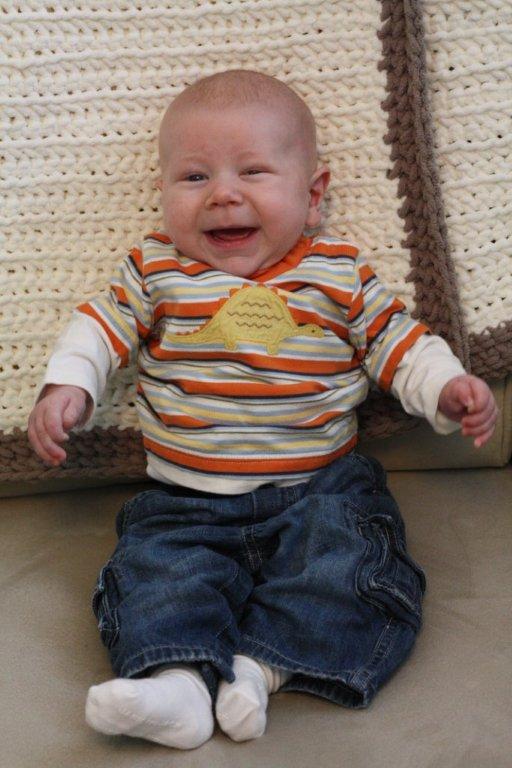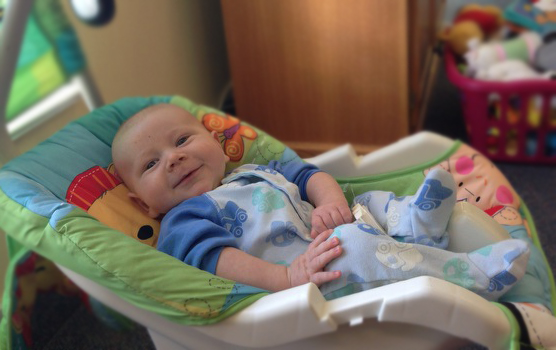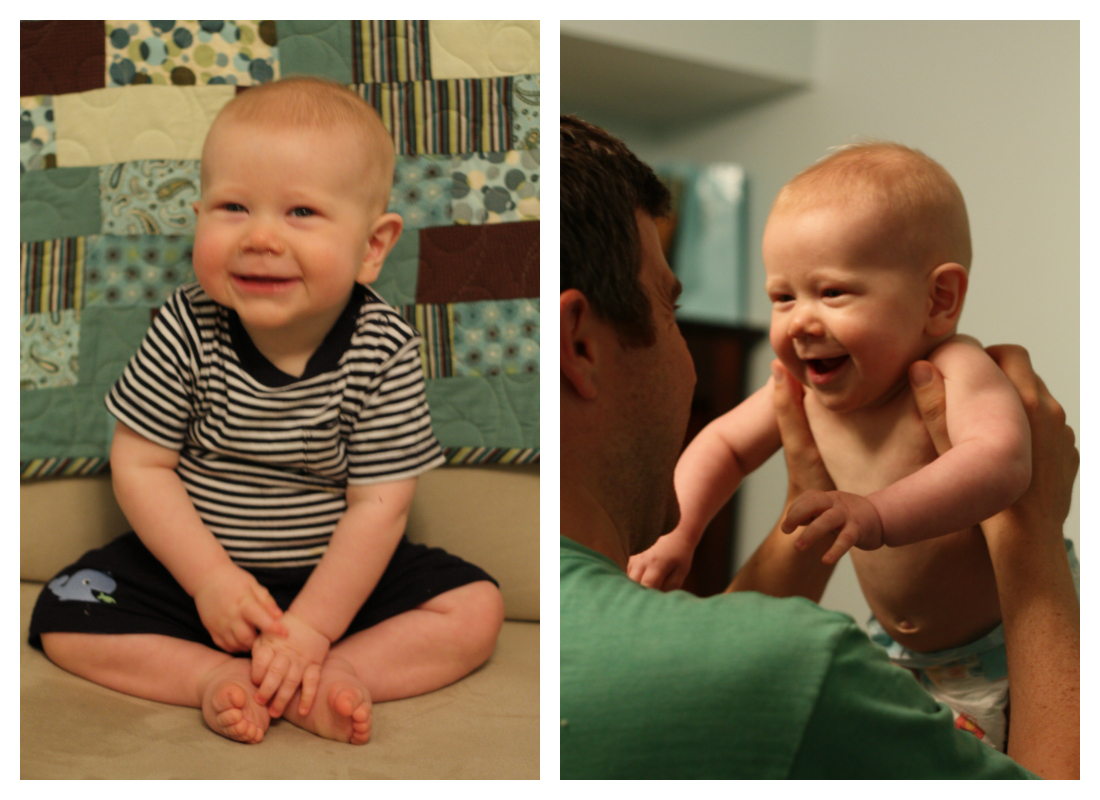
Megan Flynn with her infant son, Andrew. Photo by Simply Bliss Photography.
But that was how doctors discovered she had a rare genetic mutation that likely played a role in the development of her childhood cancer — and that led to her infant son’s rare lung cancer.
Megan’s childhood cancer
When Megan was diagnosed with a rare ovarian cancer called Sertoli-Leydig cell tumor in 1997, no one knew much about her type of cancer, let alone what caused it. After surgery and five years of follow-up scans to make sure the cancer hadn’t returned, Megan was sent on her way.
She graduated college, got married, and started having kids of her own, always wondering in the back of her mind what had caused her cancer and if it was something she should worry about with her own children. “I just never really had any answers,” she said.
So when she learned about the International Ovarian and Testicular Stromal Tumor (OTST) Registry, she was eager to sign up. “My curiosity and my desire to provide information and try to help other people was what prompted me to do it, never thinking I would help my own kids, let alone my son,” she said.
Doctors ran a blood test and found that Megan had a genetic mutation in her germline, meaning it was found in all the cells in her body.Germline mutations are hereditary, so Megan was immediately concerned about her 3-year-old daughter developing the same type of cancer she’d had.
The DICER1 mutation
Kris Ann Schultz, M.D., is a St. Baldrick’s Scholar who helped form the OTST Registry.
Some had developed the mutation in the tumor, but 65.5% had a germline mutation.
Researchers also noticed that many of the children had a family history of Sertoli-Leydig cell tumors. “And those are pretty rare tumors so it seemed like more than a coincidence that you’d see those in the same family,” said Kris Ann Schultz, M.D., a St. Baldrick’s Scholar who studies PPB and ovarian and testicular stromal tumors.
So Dr. Schultz helped form the OTST Registry at Children’s Hospitals and Clinics of Minnesota to study the connection between these rare childhood cancers.
The OTST Registry
Of the women in the registry with Sertoli-Leydig cell tumors, Dr. Schultz found that 59% of them — including Megan — had a DICER1 germline mutation.
“Finding it in the germline means that other parts of the body might be at risk,” Dr. Schultz explained. “And it may help us to understand whether their family members may be at risk.”
While Megan was worried about her daughter’s risk for developing ovarian cancer, Dr. Schultz was concerned about PPB. She recalled her original aims in establishing the registry. “We’d always said, ‘What if we could make this come full circle?’ Our hope was to take what we learned about women with ovarian tumors and use it to help pick up PPB early in their babies.”
Read the story of a 14-year-old PPB survivor and St. Baldrick’s shavee.
Andrew and PPB

Andrew at 3 months old, shortly after doctors found a cyst on his lung that they believed to be childhood cancer.
As a precaution, they performed a chest x-ray, which appeared normal.
A few weeks later, Andrew’s blood tests came back showing the DICER1 germline mutation. So at 3 months old, doctors performed a CT scan to again check for PPB.
Megan was shocked to see the image of a golf ball-sized cyst on her seemingly healthy infant son’s lung. The doctors suspected it was type 1 PPB, which starts as a cyst before progressing to a solid tumor in types 2 and 3.
“He was absolutely, 100% asymptomatic,” Megan said. “You would never, ever have known something was wrong with him.”
Dr. Schultz examined him after reading the CT scan and still could detect no sign of the cyst. “Even after I knew it was there, I couldn’t hear it, and I couldn’t see it from looking at him,” she said.
Andrew’s treatment
Surgery to remove Andrew’s cyst was scheduled immediately.
Children can develop benign cysts on their lungs, and PPB can only be diagnosed with a tissue sample obtained in surgery. But because PPB is so rare, surgeons often cut out the cyst assuming it’s benign, running the risk of leaving cancer cells behind. It only takes one cell to multiply and grow another cyst or tumor.
But Andrew’s doctors knew he had the DICER1 mutation, so they planned for the surgery as if it were a cancer surgery, making sure to remove the entire cyst without letting any cells spill back into his chest.
A few days later, Andrew was sent home with a two-inch scar as the only sign he’d had a major operation. “He tolerated it beautifully,” Dr. Schultz said.

Andrew one month after surgery to remove the PPB cyst from his lung.
They are fortunate to have caught Andrew’s cancer so early while it was still type 1, because children with type 2 or 3 PPB always need chemotherapy in addition to surgery, Dr. Schultz explained. “If you diagnose PPB at type 2 or type 3, you know you’re going to need to do much more in hopes of curing the child — much more intensive therapy with much more risk of long-term side effects and acute side effects,” she said. “But you’ll also know you’ll have less a chance of ultimately curing them of their disease.”
As with most cancers, the cure rate drops as the disease progresses. “So the goal has always been to diagnose these children as early as we can,” she explained.
And that’s exactly what happened with Andrew, thanks to Megan joining the OTST Registry. Had the doctors not known to monitor Andrew for a rare lung cancer, Dr. Schultz said, “we wouldn’t have found it at that time.”
Andrew’s future
Right now, Andrew’s chances of being cured are looking pretty good. His scar is barely visible and his last CT scan at 6 months old showed no signs of PPB.

Andrew’s last CT scan showed no signs of PPB.
“Right now we have a baby who’s just learning to crawl, just got a tooth, and loves playing with his older siblings. So we really have to take it scan by scan and enjoy the awesome miracle it is that we were able to find this so early,” she said. “We’re trying to enjoy every second of it that we can.”
Help St. Baldrick’s continue to fund this lifesaving childhood cancer research. Make a donation or see how you can organize a St. Baldrick’s event.


 SBF
Tweets »
SBF
Tweets »